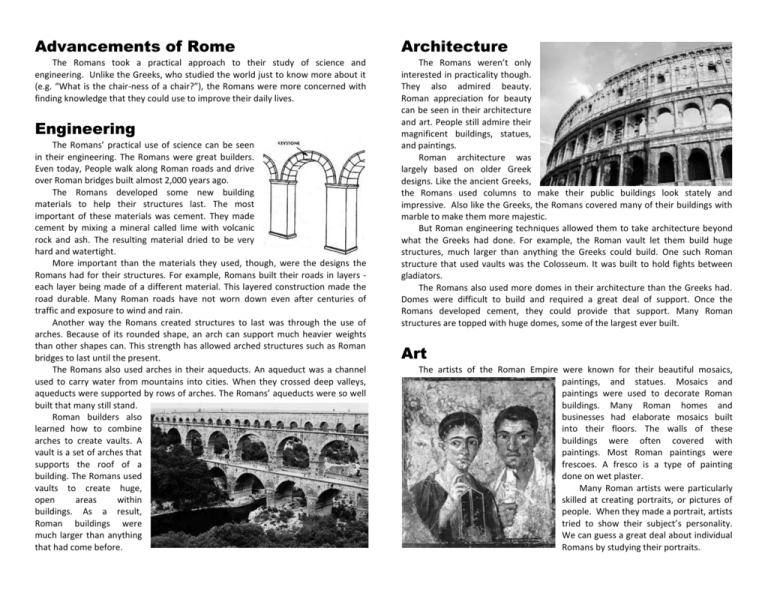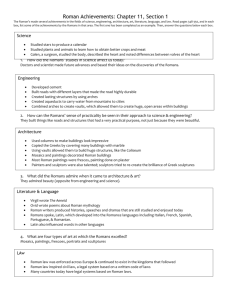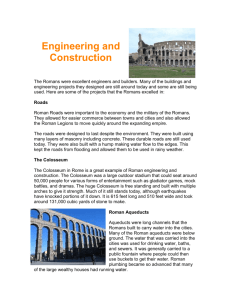Advancements of Rome The Romans took a practical approach to
advertisement

Advancements of Rome Architecture The Romans took a practical approach to their study of science and engineering. Unlike the Greeks, who studied the world just to know more about it (e.g. “What is the chair-ness of a chair?”), the Romans were more concerned with finding knowledge that they could use to improve their daily lives. The Romans weren’t only interested in practicality though. They also admired beauty. Roman appreciation for beauty can be seen in their architecture and art. People still admire their magnificent buildings, statues, and paintings. Roman architecture was largely based on older Greek designs. Like the ancient Greeks, the Romans used columns to make their public buildings look stately and impressive. Also like the Greeks, the Romans covered many of their buildings with marble to make them more majestic. But Roman engineering techniques allowed them to take architecture beyond what the Greeks had done. For example, the Roman vault let them build huge structures, much larger than anything the Greeks could build. One such Roman structure that used vaults was the Colosseum. It was built to hold fights between gladiators. The Romans also used more domes in their architecture than the Greeks had. Domes were difficult to build and required a great deal of support. Once the Romans developed cement, they could provide that support. Many Roman structures are topped with huge domes, some of the largest ever built. Engineering The Romans’ practical use of science can be seen in their engineering. The Romans were great builders. Even today, People walk along Roman roads and drive over Roman bridges built almost 2,000 years ago. The Romans developed some new building materials to help their structures last. The most important of these materials was cement. They made cement by mixing a mineral called lime with volcanic rock and ash. The resulting material dried to be very hard and watertight. More important than the materials they used, though, were the designs the Romans had for their structures. For example, Romans built their roads in layers each layer being made of a different material. This layered construction made the road durable. Many Roman roads have not worn down even after centuries of traffic and exposure to wind and rain. Another way the Romans created structures to last was through the use of arches. Because of its rounded shape, an arch can support much heavier weights than other shapes can. This strength has allowed arched structures such as Roman bridges to last until the present. The Romans also used arches in their aqueducts. An aqueduct was a channel used to carry water from mountains into cities. When they crossed deep valleys, aqueducts were supported by rows of arches. The Romans’ aqueducts were so well built that many still stand. Roman builders also learned how to combine arches to create vaults. A vault is a set of arches that supports the roof of a building. The Romans used vaults to create huge, open areas within buildings. As a result, Roman buildings were much larger than anything that had come before. Art The artists of the Roman Empire were known for their beautiful mosaics, paintings, and statues. Mosaics and paintings were used to decorate Roman buildings. Many Roman homes and businesses had elaborate mosaics built into their floors. The walls of these buildings were often covered with paintings. Most Roman paintings were frescoes. A fresco is a type of painting done on wet plaster. Many Roman artists were particularly skilled at creating portraits, or pictures of people. When they made a portrait, artists tried to show their subject’s personality. We can guess a great deal about individual Romans by studying their portraits.









